General Statewide Fishing Regulations
Regulation Changes
Note: The Fishing Regulations were revised for 2022 to include the following changes.
Community Fishing licenses are not available starting Jan. 1, 2022. Anglers who want to fish Community Fishing Program waters in 2022 will either need to have a General Fishing license or Combination Hunt/Fish license, or purchase one once their Community Fishing license expires in 2022. Community Fishing licenses purchased through Dec. 31, 2021, are valid for one year from date of purchase at designated Community Fishing Program waters.
In a move to further modernize its licensing system, the Arizona Game and Fish Department will no longer offer traditional paper “book” licenses sold through license dealers. Many current dealers will continue to sell licenses, but they will do so through AZGFD’s online purchase system. Some will no longer sell licenses. A list of dealers offering electronic license purchases is at www.azgfd.gov/license. Licenses can also be purchased directly online at license.azgfd.com or at Arizona Game and Fish Department offices.
Translation Services
If you wish to speak with a bilingual customer service representative to get information or to set an appointment at any of our offices please call (602) 942-3000 Monday through Friday between 8:00 AM to 5:00 PM and then enter the number 5 during the recorded message.
Si desea hablar con un representante de servicio al cliente bilingüe para obtener información o para programar una cita en cualquiera de nuestras oficinas, llame al (602) 942-3000 de lunes a viernes de 8:00 a. M. A 5:00 p. M. Y luego ingrese el número. 5 durante el mensaje grabado.
General Statewide Fishing Regulations
Open Statewide Jan. 1, 2021, through Dec. 31, 2022
Before you fish any body of water, be certain to review the General Statewide Regulations and the Special Regula- tions for the area you intend to fish. Anglers are responsible for knowing what regulations apply to the body of water they are fishing. See azgfd.gov for up-to-date information including any changes.
PROTECTED NATIVE FISH
The following native fish are protected statewide and may not be angled for, taken, possessed, pursued or captured: beautiful shiner, bluehead sucker, bony-tail chub, Colorado pikeminnow, desert pupfish, flannelmouth sucker, Gila top-minnow, humpback chub, Little Colorado sucker, Little Colorado spinedace, loach minnow, Mexican stoneroller, Quitob- aquito pupfish, razorback sucker, Sonora chub, spikedace, Virgin spinedace, Virgin roundtail chub, woundfin, Yaqui catfish, Yaqui chub, Yaqui topminnow, and Zuni bluehead sucker.
If any of these protected native fish are incidentally caught, they must be immediately released unharmed.
SPECIAL LICENSES AND STAMPS
As of 2014, the following stamps are no longer available: trout stamp, two-pole stamp, Colorado River stamp – California, and Colorado River stamp – Nevada. The privileges of all of these stamps are now bundled together and included in the General Fishing license, Youth Combo Hunt/Fish license, Combo Hunt/Fish license, and Short-term (one day) Combo Hunt/Fish license.
As of Jan. 1, 2019, a Utah stamp is no lon- ger needed for a licensed Arizona angler to fish on Lake Powell.
Lost Your License? If you lose or damage your license, you can get a replacement at any license dealer, Department office or online at azgfd.gov. You will be required to complete an “Affidavit for Duplicate License” form and pay an $8 replacement fee. Licenses purchased on- line can be reprinted for free.
STATEWIDE FISHING REGULATIONS
This synopsis of fishing regulations is prepared for convenience only. For specific laws and regulations relating to fishing, see Arizona Revised Statute, Title 17 Laws, and Arizona Game and Fish Commission Rules, which can be found at azgfd.gov.
Hook and Line Methods
- All new fishing and combo licenses al- low the angler to fish with two poles
or lines simultaneously. In no case are more than two lines allowed to be used at the same time. - “Angling” means the taking of fish by one line and not to exceed two hooks, by one line and one artificial lure, which may have attached more than one hook, or by one line and not to ex- ceed two artificial flies or lures.
- Fishing lines must be constantly at- tended and in immediate control.
- The hook, fly or lure must be used in such a manner that the fish voluntarily attempts to take it in its mouth.
- A single-pointed barbless hook is a fish hook with a single point, manu- factured without barbs on or which barbs have been completely closed orremoved. This does not include a tre- ble hook. Regulations limiting tackle to single-pointed barbless hooks do not eliminate the angler’s option for simultaneous fishing as defined. Anglers may use a single line with no more than two single hooks, as with a prima- ry hook and a dropper hook or fly.
Artificial Flies and Lures
- “Artificial flies and lures” means man- made devices intended as visual attractants to catch fish. Artificial flies and lures does not include living or dead organisms or edible parts of those organisms, natural or prepared food stuffs, or chemicals or organic mate- rials intended to create a scent, flavor, or chemical stimulant to the device regardless of whether it is added or ap- plied during or after the manufacturing process. (R12-4-301)
- Check the Special Regulations to determine if hooks must also be sin- gle-pointed barbless hook only.
Other Fishing Methods
- Bow and arrow, crossbow, snare, gig, spear or spear gun, or snagging are valid methods for taking carp, buffa- lofish, mullet, tilapia, goldfish, and shad statewide unless a closure or Special Regulation restricts it.
- Bow and arrow fishing for catfish (5 catfish daily bag limit, any combina- tion) is valid at Apache Lake, Canyon Lake and Saguaro Lake.
- Spear and spear gun fishing for striped bass is valid at Lake Powell, Lake Mead, Lake Mohave (between Hoover Dam and Cottonwood Landing) and Lake Pleasant. Daily bag limits vary between locations. See Special Regulations for more details.
- See R12-4-313 C for other legal methods of taking aquatic wildlife (bow and ar- row, spear or spear gun, snagging, nets, traps, etc.) for specific fish species.
Capturing Baitfish and Crayfish for Bait
- Live baitfish may be used only in areas approved for certain species.
- Live bait may be taken by minnow trap, dip net, cast net, pole and line, hand- line, crayfish net or seine.
- Cast nets shall not exceed a 4-foot ra- dius (or an 8-foot diameter).
- Seine nets shall not exceed 10 feet in length and 4 feet in width.
- Except for sunfish of the genus Lep- omis, the flesh of gamefish may not be used as bait.
- Landing nets or dip nets may be used for the capture of legal baitfish or cray- fish or only to land a legally hooked fish.
- Any unattended traps or devices used to catch or hold aquatic wildlife or fish must have attached water resistant identification legibly bearing the name, address, and fishing license number of the person using the device.
- All aquatic wildlife taken incidental-ly while capturing live bait with nets or traps must be returned immediately and unharmed to the water after being caught.
- All live legal baitfish and live cray-fish caught must be for personal use only and are not to be sold or used for commercial purposes.
- Live crayfish may only be used as bait on the same body of water where they were captured.
Daily Bag and Possession Limit
- The daily bag limit is the maximum number of fish that may be legally caught and reduced to possession in one day. Once you catch a fish and do not release it unharmed, it now counts toward your daily bag limit. This in-cludes any fish you catch and give away to someone else. Daily bag limits are for
24- hour periods (midnight to midnight). - Possession limits are twice the daily bag limits unless otherwise noted (in-cluding waters listed under the Special Regulations).
- No person shall have in their posses-sion (in the field, in camp, in transit, or at permanent residence) more than two daily bag limits of any fish species. Fish are in an angler’s possession wheth-er on hand, in cold storage, in transport, at home, or elsewhere under their ownership.
- An angler may take daily bag limits of several types of fish per day. Daily bag limits apply to all Arizona waters fished that day. An angler who has taken and kept a bag limit of fish may not continue to fish for the same species that day. Ad-ditionally, an angler who has taken and kept a possession limit of fish (twice the daily bag limit) may not continue to fish on subsequent days, unless the angler has first consumed or given away all or a portion of the possession limit.
- Where only catch-and-release fishing is allowed, fish must immediately be returned unharmed to the water after being caught.
- Unlicensed children under the age of 10 and unlicensed blind residents may take their own separate daily bag lim-its as established for each species. They also are entitled to the use of two poles.
Closures to Fishing
Sensitive areas may be permanently closed to fishing. Some areas (streams) being actively restored for native trout re-covery efforts may be temporarily closed to fishing.
Length Limits
Most fishing waters in Arizona do not have length limits. Check the Special Regulation waters (including Designated Community Fishing Program waters) to determine if length limits apply to species found in the water you wish to fish. A minimum length means that a fish shorter than a designated length must be returned to the water unharmed immediately after being caught.
How to Measure the Length of a Fish
- Total length is the standard.
- Place the fish flat on its side with the jaw closed.
- 3. Squeeze the tail fin lobes together to produce the maximum total length.
- Measure in a straight line from the tip of the snout to the extreme tip of the tail.
- Where length limits apply, you must re-lease unharmed all fish not measuring within the legal length limit.
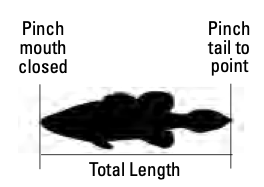
Transport and Storage of Fish
- Anglers may transport up to a posses-sion limit of any fish species as long as they are not alive.
- It is illegal to transport live fish, includ-ing in live wells or other containers. All fish must be killed or released before transportation from the body of water. This does not apply to some live bait-fish that are transported from licensed bait dealers.
- Fish must be transported in a way that they can be counted and species of fish can be identified. All fish must have a piece of skin attached to the carcass or fillets so species can be determined. If minimum length limits apply to the species, the head, tail and skin must be intact so fish length and species can be determined.
LICENSE REVOCATION AND CIVIL LIABILITY
License Revocation
You can have your fishing, hunting and trapping license privileges revoked by the Commission for up to five years or more for a conviction of:
- unlawful taking or possession of wildlife (including fish)
- careless use of firearms resulting in hu-man injury or death
- destroying or injuring livestock
- acts of vandalism or littering while hunting or fishing
- unlawful entry into a closed area for purposes of taking wildlife
- unlawful posting of state or federal lands
- residency license fraud
Such revocations may be recognized by other states that are members of the Interstate Wildlife Violator Compact.
You may also be civilly liable for the loss of wildlife to the state (see below). (A.R.S. 17-340)
Civil Liability
Under state law (A.R.S. 17-314) anyone who is found to have unlawfully wounded or killed, or unlawfully possessed any of the following wildlife may be subject to civil action by the Arizona Game and Fish Com-mission. The civil damages may reach as much as $8,000 per incident. (A.R.S. 17-314)
COMMON VIOLATIONS
Fish or Take Aquatic Wildlife Without a License or With the Wrong License
In order to fish or take any aquatic wild-life in Arizona, you must have a valid fishing license, as applicable, in your pos-session if you are 10 years of age or older. You should check your license every time that you go fishing. (A.R.S. 17-331)
Fishing with an Unattended Line
Anytime you are fishing your line must be constantly attended and within your immediate control. Before you leave the area, even for a short while, your line must be reeled in and removed from the water. (A.R.S. 17-301C)
Exceed Daily Bag and/or Possession Limit
Fish may only be taken as prescribed by Commission Order for daily bag and/or possession limit. Please consult Commis-sion Orders for specifics. After you have caught and kept your daily bag limit, it is illegal to continue to:
- Fish for that same species of fish and practice catch-and-release;
- Fish for that same species of fish with the intent of replacing any fish in your bag with a “better fish” — this is also known as culling;
- Fish for that same species of fish with the intent of “helping” another angler get his/her daily bag limit; or
- Fish for a species of fish if you already have the possession limit (twice the daily bag limit) for that species (e.g., in an ice chest at camp, or at home in your freezer). (A.R.S. 17-309A14 and 15)
Possess Unlawfully Taken Aquatic Wildlife
Any aquatic wildlife that is unlawful-ly taken may not be legally possessed. Whether or not you were involved in the illegal taking of wildlife or fish, you can-not legally possess such parts thereof. (A.R.S. 17-309A16)
Obtain License or Permit by Fraud
Only persons who have been a domiciled resident (A.R.S. 17-101A17) of Arizona for the six months immediately preceding the date of application, or members or spouse of a member of the armed forces of the United States who are on active duty and stationed in this state for ei-ther permanent or temporary duty may obtain resident fishing licenses and permits. If the residency of the applicant is in question, the following factors will be considered: Does not claim residency for any purpose in any other state or jurisdiction; has been issued an Arizona driver’s license or an Arizona commercial driver’s license; is employed full-time in Arizona; files federal and/or state income taxes as an Arizona resident; votes in Arizona; is enrolled in, or has minor children enrolled in an Arizona public school without payment of non-resident tuition.
Unlawful Possession, Transportation or Release of Live Fish
Except for designated baitfish, it is illegal for a person to transport live fish away from the waters where caught. It is also illegal to release live fish into a body of water if they did not come from that body of water or without a proper stocking permit. (A.R.S. 17-306 and 17-309A 1, R12-4-313 and R12-4-314)
Littering While Taking Aquatic Wildlife
All anglers are responsible for cleaning up after themselves. All camp and shoreline areas should be left clean. Bait containers, wrappers, hooks, line and associated debris constitute litter and should be picked up, packed out, and properly disposed of. Also, all anglers are responsible for the proper care and disposal of their fish carcasses. Shorelines and waterways must be kept as clean as they were found. (A.R.S. 17-309A9)
Unlawful Possession or Transportation of Live Crayfish
Except for Yuma County and a portion of La Paz County or under a live wildlife license authority, it is unlawful for a per-son to import, transport or possess live crayfish other than on or at the body of water where caught. (A.R.S. 17-309A1, R12-4-314)
Other Violations
- Refuse to produce a license or fish for inspection upon request of an enforcement officer.
- Snag or attempt to snag fish except as allowed by R12-4-313.
- Attempt to take fish by hand, with or without a hook.
- Use a landing net to capture fish, ex-cept to land a legally-hooked fish. Dip or seine nets are only legal for the capture of baitfish.
- Waste game fish by intentionally leaving or abandoning any fillets or commonly edible portion of any fish.
- Offer any recreationally caught fish or aquatic wildlife for sale or barter, except as authorized by R12-4-305.P.
- Use electrical devices, explosives, fire-arms, drugs, chemicals or poison that may kill or injure fish and aquatic wildlife.
- Use or possess live bait in areas or on waters where fishing is restricted to the use of artificial flies and lures only, or where the use of live baitfish is restrict-ed.
It is every angler’s responsibility to protect our fishing heritage. You can help ensure responsible and ethical fishing by reporting violations immediately to our Operation Game Thief hotline 1-800-352-0700.
Live Baitfish – Legal Species, Legal Areas and Regulations
Live baitfish that are legal for use in Arizona include only those species identified here. No other fish species may be used as live bait.
Live baitfish may be obtained and used only in the legal areas identified below.
No live baitfish may be used or possessed while on any waters in Coconino, Apache, Navajo, Pima and Cochise counties. All other counties have specific baitfish regulations by body of water or area.
Please dispose of all unwanted baitfish by burying them on land far from the water.
It is illegal
- To release live baitfish or other live fish into any Arizona waters.
- To use or possess any restricted live baitfish while fishing waters prohibiting use of that baitfish.
- To sell live baitfish (or waterdogs) without a Live Baitfish Dealers License.
- To keep or harm any game fish or aquatic wildlife inciden-tally taken while capturing live baitfish with seines, dip nets, traps or cast nets.
Legal Areas Anglers May Transport And Use Live Baitfish
Arizona Live Baitfish License Dealers may offer for sale any of the following: fathead minnows (most common), golden shiner and goldfish. Any legal baitfish obtained from a licensed baitfish dealer may be transported for use only to the following legal areas.
These three baitfish species may also be collected and used alive onsite only in the identified legal areas.
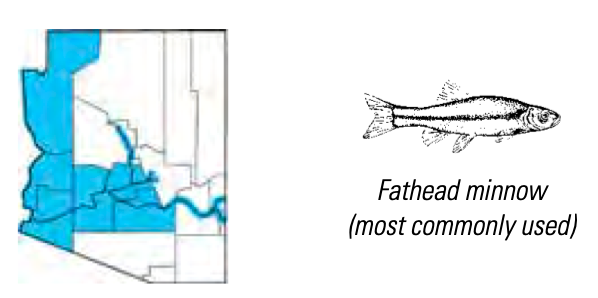
Legal Areas Allowed
Fathead minnows are permitted on all waters of the counties of La Paz, Maricopa Pinal and Yuma. These baitfish may be used in all waters of Mohave county except the Virgin River. Additional open areas include: 1) the mainstream portions of the Gila and Salt rivers, and that portion of the Verde River below the Tuzigoot Bridge, including impounded reservoirs, 2) Tonto Creek from Gisela downstream, 3) those portions of Apache, Roosevelt, Pleasant and Horseshoe lakes lying outside of these counties, and 4) that portion of the San Francisco River in Greenlee County.
Notes: Live baitfish may not be transported to the Verde River upstream from Horseshoe Dam and the Salt River above the Roosevelt Diversion Dam in Gila County. Fathead Minnows are permitted for use as live bait only when caught and used on site at Riggs Flat Lake in Graham County. No waters of any other counties are open.
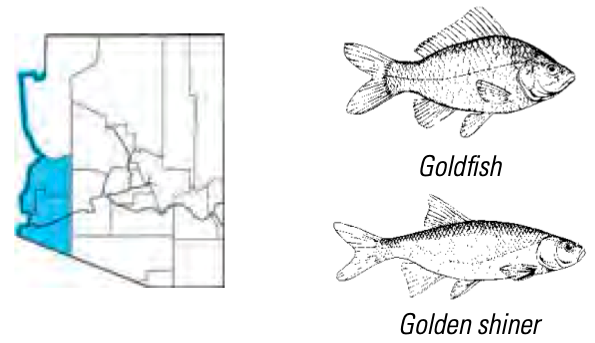
Legal Areas Allowed
Golden shiner and goldfish are permitted on all waters of the counties of La Paz and Yuma. Open areas include: 1) Lake Mead, and 2) the Colorado River down-stream from Hoover Dam to the Southern International Boundary with Mexico, including impounded reservoirs, and 3) Alamo Lake. No waters of any other counties are open.
Waterdogs
Waterdogs are NOT considered baitfish, however they have specific regulations governing their use in Arizo-na. For regulations on live waterdog legal areas, capture, possession, and transportation see R12-4-313 B3 and R12-4-314 B & C.
No live waterdogs or salamanders may be taken, used or possessed in that portion of Santa Cruz County lying east and south of State Highway 82, or that portion of Cochise County lying west of the San Pedro River and south of State Highway 82 (this includes Parker Canyon Lake).
Legal live baitfish can be obtained from licensed bait dealers and from wild capture for personal use only. For regulations on legal capture methods, possession and transport of live baitfish, see:
- Capturing baitfish and crayfish for bait
- Lawful methods R12-4-313 A thru E
- Possession of live fish R12-4-314 B & C
- Possession and transportation of live baitfish R12-4-314 B and C
- Seasons for lawfully taking fish R12-4-313 A thru C
Live Baitfish – Legal Species, Legal Areas and Regulations
The following live baitfish may be collected and used onsite only in the identified legal areas. It is illegal to transport any of these live baitfish to or from these waters.
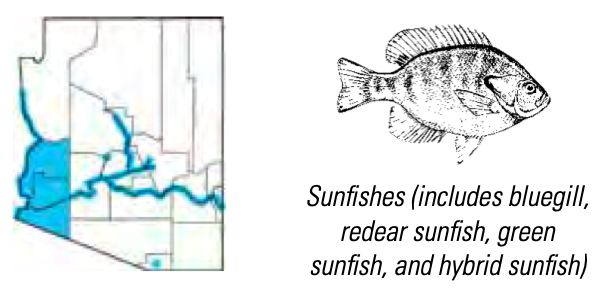
Legal Areas Allowed
Sunfishes are permitted on all waters of the counties of La Paz and Yuma. Additional open areas include: 1) the Colorado River south of the Nevada-California boundary downstream to the Southern International Boundary with Mexico, including impounded reservoirs, 2) the Gila, Salt, and Verde rivers, including impounded reservoirs, 3) community waters in Maricopa County, 4) Lake Pleasant, 5) Alamo Lake, and 6) Patagonia Lake.
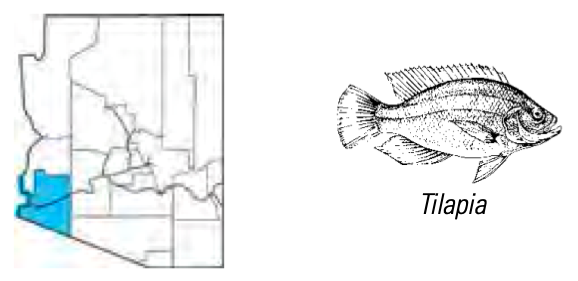
Legal Areas Allowed
Tilapia are permitted on all waters of Yuma County. Additional open areas include: 1) waters in La Paz County located west of Highway 95 and south of Interstate 10, and 2) the Colorado River from the Palo Verde Diversion Dam downstream to the Southern International Boundary with Mexico, including impounded reservoirs. No waters of any other counties are open.
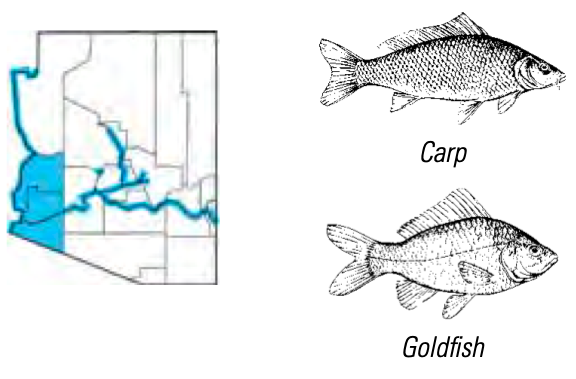
Legal Areas Allowed
Carp and Goldfish are permitted on all waters of the counties of La Paz and Yuma. Additional open areas include: 1) Lake Mead, 2) the Colorado River down-stream from Hoover Dam to the Southern International Boundary with Mexico, including impounded reservoirs, 3) the Gila, Salt, and Verde rivers, including impounded reservoirs, 4) community waters in Maricopa County, 5) Lake Pleasant, and 6) Alamo Lake.
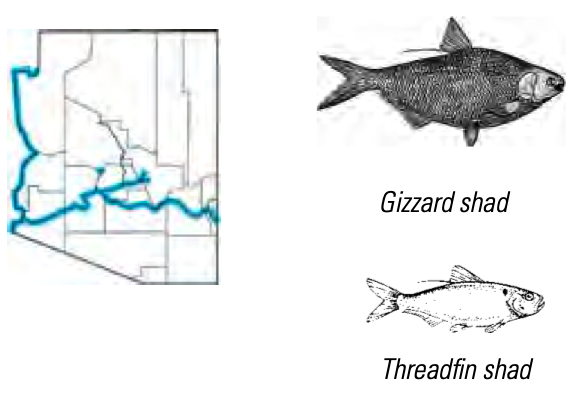
Legal Areas Allowed
Gizzard shad are permitted for use as live bait only from the following areas: 1) the Colorado River south of Separation Canyon downstream to the Southern In-ternational boundary with Mexico, including impounded reservoirs (e.g., Lake Mead, Lake Mohave and Lake Havasu) and directly connected backwaters (e.g., Topock Marsh and Mittry Lake), 2) the Gila and Salt Rivers, including impounded reservoirs (e.g., Roosevelt Lake and Apache Lake), 3) community waters in Mar-icopa County, and 4) Lake Pleasant.
Threadfin shad are permitted on all waters of the counties of La Paz, Maricopa, Pinal and Yuma. Threadfin shad may be used in all waters of Mohave County ex-cept the Virgin River. Additional open areas include: 1) the mainstream portions of the Gila and Salt rivers, and that portion of the Verde River below the Tuzigoot Bridge, including impounded reservoirs, 2) Tonto Creek from Gisela downstream, 3) those portions of Apache, Roosevelt, Pleasant and Horseshoe lakes lying out-side of these counties, 4) that portion of the San Francisco River in Greenlee County and 5) Patagonia Lake.
